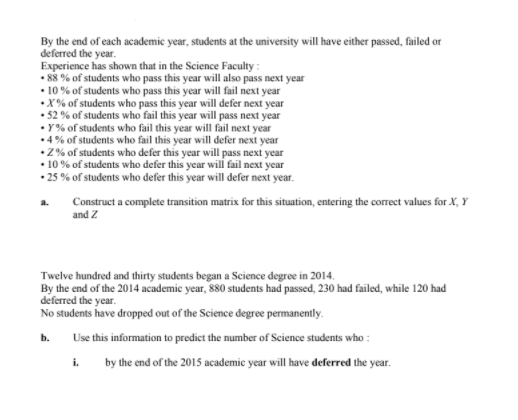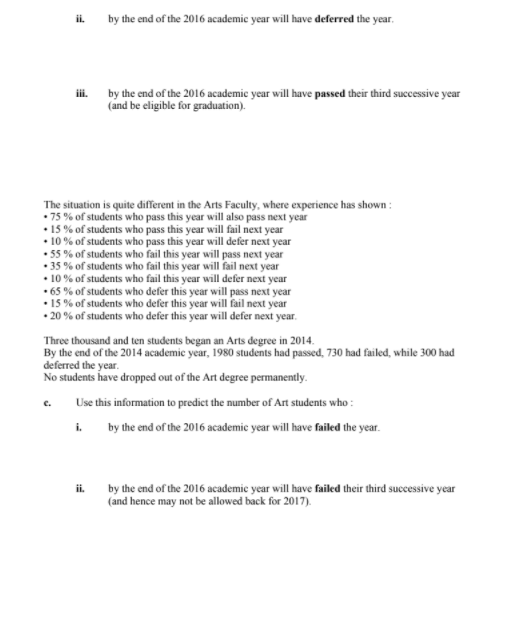By the end of each academic year, students at the university will have either passed, failed or deferred the year. Experience has shown that in the Science Faculty: • 88 % of students who pass this year will also pass next year • 10% of students who pass this year will fail next year •X% of students who pass this year will defer next year • 52 % of students who fail this year will pass next year • Y% of students who fail this year will fail next year • 4 % of students who fail this year will defer next year •2% of students who defer this year will pass next year • 10% of students who defer this year will fail next year • 25 % of students who defer this year will defer next year. Construct a complete transition matrix for this situation, entering the correct values for X, Y a.
By the end of each academic year, students at the university will have either passed, failed or deferred the year. Experience has shown that in the Science Faculty: • 88 % of students who pass this year will also pass next year • 10% of students who pass this year will fail next year •X% of students who pass this year will defer next year • 52 % of students who fail this year will pass next year • Y% of students who fail this year will fail next year • 4 % of students who fail this year will defer next year •2% of students who defer this year will pass next year • 10% of students who defer this year will fail next year • 25 % of students who defer this year will defer next year. Construct a complete transition matrix for this situation, entering the correct values for X, Y a.
Glencoe Algebra 1, Student Edition, 9780079039897, 0079039898, 2018
18th Edition
ISBN:9780079039897
Author:Carter
Publisher:Carter
Chapter10: Statistics
Section10.6: Summarizing Categorical Data
Problem 28PPS
Related questions
Question

Transcribed Image Text:By the end of each academic year, students at the university will have either passed, failed or
deferred the year.
Experience has shown that in the Science Faculty :
• 88% of students who pass this year will also pass next year
• 10% of students who pass this year will fail next year
•X% of students who pass this year will defer next year
• 52 % of students who fail this year will pass next year
• Y% of students who fail this year will fail next year
•4% of students who fail this year will defer next year
2% of students who defer this year will pass next year
10% of students who defer this year wil fail next year
• 25 % of students who defer this year will defer next year.
Construct a complete transition matrix for this situation, entering the correct values for X, Y
and Z
a.
Twelve hundred and thirty students began a Science degree in 2014.
By the end of the 2014 academic year, 880 students had passed, 230 had failed, while 120 had
deferred the year.
No students have dropped out of the Science degree permanently.
b. Use this information to predict the number of Science students who :
i.
by the end of the 2015 academic year will have deferred the year.

Transcribed Image Text:i. by the end of the 2016 academic year will have deferred the year.
by the end of the 2016 academic year will have passed their third successive year
iii.
(and be eligible for graduation).
The situation is quite different in the Arts Faculty, where experience has shown :
• 75 % of students who pass this year will also pass next year
• 15% of students who pass this year will fail next year
• 10% of students who pass this year will defer next year
• 55 % of students who fail this year will pass next year
• 35 % of students who fail this year will fail next year
• 10% of students who fail this year will defer next year
• 65 % of students who defer this year will pass next year
• 15 % of students who defer this year will fail next year
• 20 % of students who defer this year will defer next year.
Three thousand and ten students began an Arts degree in 2014.
By the end of the 2014 academic year, 1980 students had passed, 730 had failed, while 300 had
deferred the year.
No students have dropped out of the Art degree permanently.
Use this information to predict the number of Art students who :
c.
i. by the end of the 2016 academic year will have failed the year.
ii.
by the end of the 2016 academic year will have failed their third successive year
(and hence may not be allowed back for 2017).
Expert Solution
This question has been solved!
Explore an expertly crafted, step-by-step solution for a thorough understanding of key concepts.
Step by step
Solved in 3 steps

Knowledge Booster
Learn more about
Need a deep-dive on the concept behind this application? Look no further. Learn more about this topic, statistics and related others by exploring similar questions and additional content below.Recommended textbooks for you

Glencoe Algebra 1, Student Edition, 9780079039897…
Algebra
ISBN:
9780079039897
Author:
Carter
Publisher:
McGraw Hill

Algebra & Trigonometry with Analytic Geometry
Algebra
ISBN:
9781133382119
Author:
Swokowski
Publisher:
Cengage

Glencoe Algebra 1, Student Edition, 9780079039897…
Algebra
ISBN:
9780079039897
Author:
Carter
Publisher:
McGraw Hill

Algebra & Trigonometry with Analytic Geometry
Algebra
ISBN:
9781133382119
Author:
Swokowski
Publisher:
Cengage